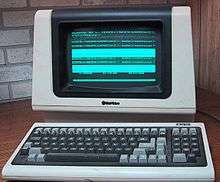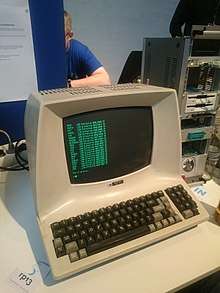TeleVideo
TeleVideo Corporation was a U.S. company that achieved its peak of success in the early 1980s producing computer terminals. TeleVideo was founded in 1979 by K. Philip Hwang, a Utah State University graduate born in North Korea[1] who had run a business producing CRT monitors for arcade games since 1975. The company was headquartered in San Jose, California.

| Corporation | |
| Industry | Computer hardware |
| Fate | Chapter 11 bankruptcy in 2006; disestablished in 2011 |
| Founded | 1975 |
| Founder | K. Philip Hwang |
| Defunct | 30 September 2011 |
| Headquarters | , |
| Products | Terminals, Graphic boards for Terminals, TeleVideo TS-800, TS-802, TS-803, TeleVideo TS-1603, TeleVideo TPC-1, TeleVideo TS-806, TS-816 |
| Website | www |
TeleVideo's terminal protocol was popular in the early days of microcomputers and was widely supported by applications as well as terminal emulators (often referred to as "TeleVideo 925 emulation").[3]
TeleVideo also built CP/M-compatible 8-bit desktop and portable personal computers based on the Z80 processor. Up to sixteen of these machines could be connected to proprietary multi-user systems through serial interfaces.[4] In April, 1983, TeleVideo introduced an MS-DOS 2.0 compatible personal computer based on the Intel 8088. This was introduced as the Model TS-1603 and included 128 KB RAM (expandable up to 256 KB), integrated monitor, modem and keyboard. The Model TS-1603 ran both TeleVideo PC DOS 2.0 and CP/M-86 1.1.
The company later turned to manufacturing Windows compatible thin client computers,[5] but eventually sold this business line to Neoware in October 2005.[6] The latter was subsequently taken over by Hewlett-Packard in 2007.[7]
On March 14, 2006, TeleVideo, Inc. filed a voluntary petition for reorganization under Chapter 11 of the United States Bankruptcy Code.[8][9]
After more than 35 years in business and with millions of terminals sold worldwide TeleVideo discontinued the manufacturing and sales of all terminal products as of September 30, 2011.[10]

Products

- Terminals[11]: TeleVideo 905, 910, 912, 914, 920, 921, 922, 924, 925, 9320, 935, 950, 955, 965, 970, 990, 995-65, Personal Terminal
- Graphic boards for Terminals: 914GR, 924GR, 970GR
- CP/M systems: TeleVideo TS-800, TS-802[12], TS-803
- CP/M-86/MS-DOS systems: TeleVideo TS-1603
- TeleVideo TPC-1, a portable CP/M system similar to the Osborne-1
- Early multi-user systems: TeleVideo TS-806 (6 users), TS-816 (16 users)[13]
References
- USU Alumni newsletter, Feb. 2004 Archived 2009-05-17 at the Wayback Machine
- Installation and User's Guide, http://vt100.net/televideo/tvi925_ig.pdf
- e.g. Rogue Wave's HostAccess Archived 2009-05-03 at the Wayback Machine
- "Eight bit CP/M-based systems connect into 16-user network". IEEE Computer, Volume 16 Number 2, Pages 88-93. 1983-02-01. Retrieved 2009-05-14.
- "TeleVideo Releases TeleCLIENT Windows-Based Terminals With Microsoft RDP 5.0". Press release. 2000-09-26. Retrieved 2009-05-14.
- "TeleVideo, Inc. Announces Sale of Thin Client Business to Neoware Systems, Inc". Press release. 2005-10-07. Archived from the original on June 6, 2012. Retrieved 2009-05-14.
- "HP Closes Neoware Acquisition". HP Newsroom. HP. 2007-10-01. Retrieved 2009-05-14.
- "TELEVIDEO INC, Form 8-K, Current Report, Filing Date Mar 15, 2006". secdatabase.com. Retrieved May 15, 2018.
- "TeleVideo Chapter 11 Petition" (PDF). PacerMonitor. PacerMonitor. Retrieved 7 June 2016.
- http://www.televideo.com/
- http://terminals-wiki.org/wiki/index.php/Category:TeleVideo
- http://www.old-computers.com/museum/computer.asp?st=1&c=610
- www.vintagecomputer.net/televideo/ts-816/